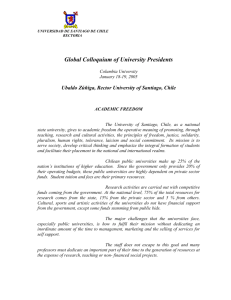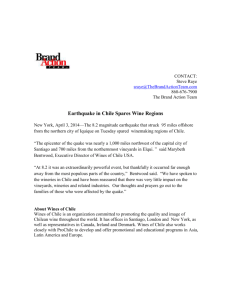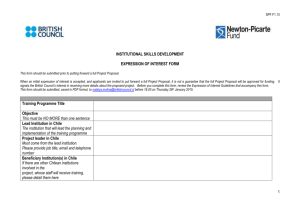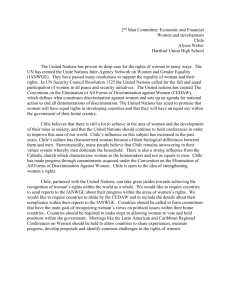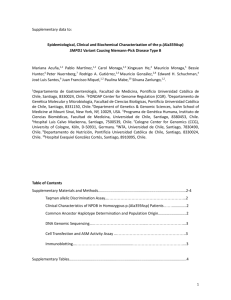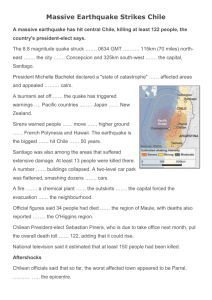itinerary - Neotropical Bird Club
advertisement
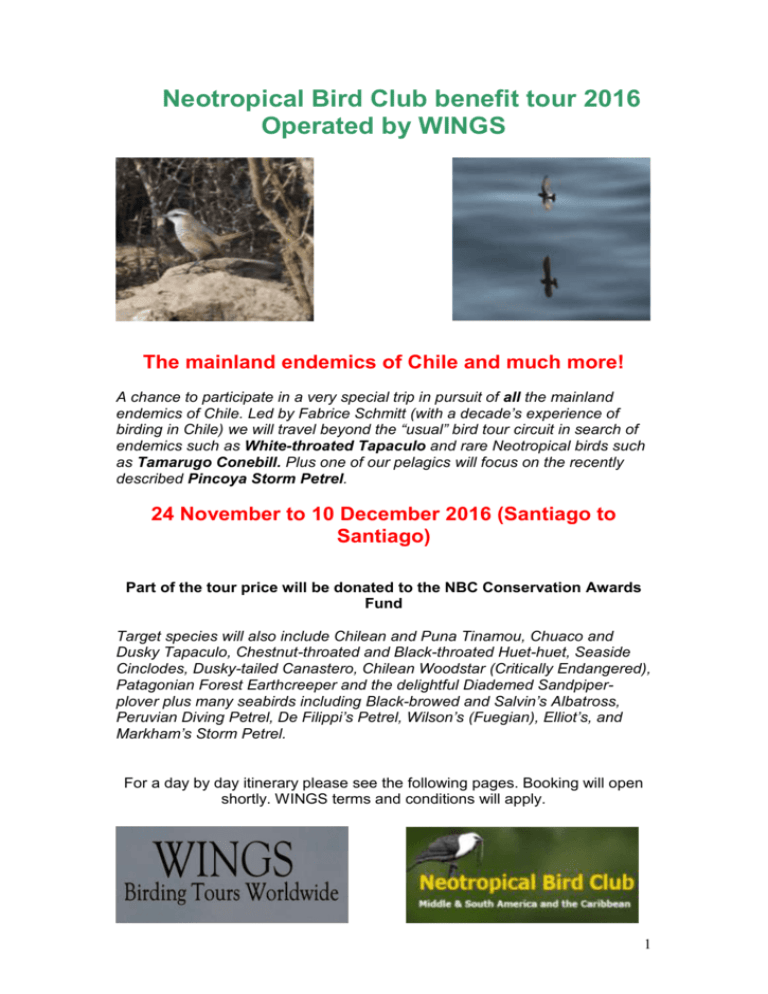
Neotropical Bird Club benefit tour 2016 Operated by WINGS The mainland endemics of Chile and much more! A chance to participate in a very special trip in pursuit of all the mainland endemics of Chile. Led by Fabrice Schmitt (with a decade’s experience of birding in Chile) we will travel beyond the “usual” bird tour circuit in search of endemics such as White-throated Tapaculo and rare Neotropical birds such as Tamarugo Conebill. Plus one of our pelagics will focus on the recently described Pincoya Storm Petrel. 24 November to 10 December 2016 (Santiago to Santiago) Part of the tour price will be donated to the NBC Conservation Awards Fund Target species will also include Chilean and Puna Tinamou, Chuaco and Dusky Tapaculo, Chestnut-throated and Black-throated Huet-huet, Seaside Cinclodes, Dusky-tailed Canastero, Chilean Woodstar (Critically Endangered), Patagonian Forest Earthcreeper and the delightful Diademed Sandpiperplover plus many seabirds including Black-browed and Salvin’s Albatross, Peruvian Diving Petrel, De Filippi’s Petrel, Wilson’s (Fuegian), Elliot’s, and Markham’s Storm Petrel. For a day by day itinerary please see the following pages. Booking will open shortly. WINGS terms and conditions will apply. 1 NBC benefit tour to Chile 2016 Operated by WINGS Dates: 24 November to 10 December, 2016 A fascinating collection of birds coupled with some of the most spectacular scenery on earth makes birding in Chile a superb experience. This narrow strip of territory, 150 miles wide by 2,500 miles long, is a land of immense variety and beauty: from the grandeur of wave-dashed Pacific beaches to the solitude of high Andean lakes, and from the luxuriant Nothofagus and Araucaria forest in the Lake District to the utterly barren Atacama, the most perfect of deserts. Travelling the length of the country impresses upon one the remarkable similarities of climate, vegetation and topography, not to mention convergent evolution, between the Northern and Southern Hemispheres. Our NBC Benefit tour to Chile will be focused on the endemic, restricted range, endangered and recently described species found in Central and North Chile (from Puerto-Montt to Arica). Our itinerary has been specially designed in order to have a great chance to see all these sought-after species. We will try for all of the 10 Chilean continental endemics, together with some rarely seen species on usual tours to Chile, such as Horned Coot, Red-backed Sierra-Finch, Chestnut-throated Huet-huet, Tamarugo Conebill and the recently described Patagonian Forest Earthcreeper. In the extreme North of the country, we will make a special effort to see the Critically Endangered Chilean Woodstar, whose total population is probably less than 400 individuals, and considering the actual rate of habitat destruction may sadly disappear in the not too distant future. We will also pay lots of attention to seabirds, and will organize a pelagic trip off Quintero (one of the best seabirding area in the world) and another one off Puerto-Montt to look mainly for the Pincoya Storm Petrel, a species described as recently as 2012. Near Arica, we will also visit one of the most incredible discoveries of the recent years in Chile, a Markham’s Storm Petrel colony in the middle of the Atacama Desert! The avifauna ranges from penguins, rheas, flamingoes and a superb selection of southern waterfowl and shorebirds to 30 species of ovenbirds (furnariids), eight tapaculos (three of them endemic), nine sierra-finches, and five siskins. Our tour coincides with the austral spring, when bird activity is at its height, and is designed to take in most of the major regions of this diverse land. Chile is throughout a safe and friendly country in which to travel, and has an excellent infrastructure for tourism. 2 Day by day itinerary Day 1: The tour begins at 12 noon in the lobby of our Santiago hotel. If flight arrival times allow, we’ll visit some nearby areas for an introduction to the birdlife of Chile’s Central Valley. If the water levels allow, we will visit the Lampa wetlands looking for South American Painted Snipe, Black-headed Duck, and waterbirds (Black Rail is a possibility too). Night in Santiago. Day 2: The magnificent High Andes, their snow-capped peaks dominating the eastern horizon, are only a short drive from Santiago and will be our venue for the next two days. We’ll visit two sites (day 2 and day 5) with slightly different avifaunas, both in spectacular rugged settings. The birdlife of this region includes the flashy White-sided Hillstar, Creamy-rumped Miner, Greybreasted Seedsnipe, Grey-flanked Cinclodes, numerous ground-tyrants, sierra-finches, and ovenbirds (including the endemic Crag Chilia), the comical Moustached Turca (a roadside tapaculo!), huge Andean Condors, and with luck the ultimate shorebird – Diademed Sandpiper-Plover. Nights in Santiago. Day 3: Central Chile, at the same latitude as southern and central California, has a Mediterranean climate and chaparral-like vegetation known as matorral. Extensive vineyards and the introduced California Quail, California poppy, and towering eucalyptus trees cultivate the illusion that one is in the Northern Hemisphere. To dispel any doubts we’ll spend the day birding our way to the coast at San Antonio, passing through a variety of habitats where birds could include Spot-flanked Gallinule, Wren-like Rushbird, and Rufous-tailed Plantcutter. We’ll make a special effort to see the handsome Many-colored Rush-Tyrant and the endemic Dusky and White-throated Tapaculo. Along the coast we should see Peruvian Booby, Peruvian Pelican, and the beautiful Inca Tern. Night in Quintero. Day 4: Today we’ll make an early departure by boat a short distance offshore into the famous Humboldt Current which, by upwelling like its northern counterpart the California Current, provides a nutrient-rich base that supports a vast seabird population. Up to seven species of albatross are possible including Salvin’s, Buller’s, and Royal, while Southern Fulmar, De Filippi’s and Westland Petrels, Peruvian Diving Petrel, and others are regularly seen. To bring us back to earth, we’ll spend the afternoon birding along the coast, looking for Seaside Cinclodes and Great Shrike-tyrant, before the drive back to Santiago. Night in Santiago. Day 5: We make an early start and drive eastwards towards the Farellones ski resort. On the way we hope to see the secretive Chilean Tinamou, and at higher elevation the species we may have missed during our first day in the Andes. After our morning there, we will head on the motorway to Talca and then to Vilches. At dusk we will look for the hard to see Rufous-legged Owl before spending the night in our quiet and comfortable forest lodge at Vilches, just outside the park boundary dining in and enjoying some good local dishes. Day 6: We will have a full day to explore the extensive forest of Altos de Lircay National Park that sits in the Andean foothills. This is old Nothofagus 3 forest with spectacular tree and plant life and interesting geological rarities along with a host of forest bird species. In particular we will be listening for the nasal scolding of Chile's least known Tapaculo, the Chestnut-throated Huethuet, perhaps the least often found Chilean virtual endemic on most tours. We will also be looking for more Nothofagus forest specialties such as the Austral Parakeet (the world's most southerly parrot species), the plump Chucao Tapaculo with its explosive voice, Magellanic Tapaculo and Patagonian Sierra-Finch. This will be our best opportunity to see the truly spectacular Magellanic Woodpecker, which is quite common here and there´s an outside chance of the rare and difficult to find Chilean Hawk. We will also visit Colbún lake where our main targets are the large, spectacularly colourful and very noisy macaw like Burrowing Parrot and the chance on the lake or the Rio Claro to find the rare and beautiful Spectacled Duck. After a day´s labour we return to our Vilches lodge and again dine in the excellent restaurant there. Day 7: Early in the morning we will travel to Temuco making selected stops along the way including Santa Elena lagoon, south of Chillan, where we can look for the Ticking Doradito along with the lake's other specialities. We will spend the end of the afternoon birding at Cerro Ñielol where the possibilities include Black-throated Huet-huet, Rufous-tailed Hawk, Des Mur's Wiretail, Chucao Tapaculo, the near endemic Slender-billed Parakeet and Ochreflanked Tapaculo. At dusk we will have another chance for Rufous-legged Owl. Night in Temuco. Day 8: We set off in the morning to the very beautiful Conguillío National Park. In this fantastic higher altitude Nothofagus and Araucaria forest with excellent mountain views we'll look for the recently split Patagonian Forest Earthcreeper, the Flying Steamer-duck, along with Magellanic Tapaculo, Austral Parakeet, Striped Woodpecker, Chilean Flicker, White-throated Treerunner and other forest species. Night in Temuco. Day 9: This will be a long traveling day towards Puerto-Montt. We plan to arrive early there, in order to have enough time to search for some good birds including wintering Hudsonian Godwit, or the local Flightless or ‘Chiloe’ Steamer-duck. Night in Puerto-Montt. Day 10: The main reason to travel south to Puerto Montt, is to make a pelagic off Puerto-Montt, to look for the recently described Pincoya Storm Petrel. Described as recently as 2012, the Pincoya Storm Petrel is only known from the Corcovado Gulf. A full morning will be dedicated to that most sought-after seabird. In the afternoon we will fly back to Santiago. Night in Santiago. Day 11: We will catch an early flight to Calama, and then drive to San Pedro de Atacama through the famous driest desert in the World. In the same afternoon, we will drive to some high altitude lakes, looking for two very restricted range species, the Horned Coot and Tamarugo Conebill! Both species are rarely seen on any other tours, and fortunately are fairly common near San Pedro. In the San Pedro salt plain we might find the three species of 4 Andean flamingoes, plus Puna Plover and Andean Avocet. Night in San Pedro Day 12: Another early departure towards the stunning El Tatio Geysers! Lots of interesting high elevations species can be seen here, including Goldenspotted Ground-Dove, Puna Tinamou, White-winged Cinclodes and even the rare Puna Rhea. But the main attraction will be the extremely restricted Redbacked Sierra-finch, and the rare Grey-bellied Shrike-Tyrant (the andecola ssp that may be split from the one found in Patagonia). Depending upon flight times, we will fly back to Santiago for the night, or directly to Arica. Night in Santiago (or Arica). Day 13: If we spent the previous night in Santiago we will take a morning flight north to the coastal town of Arica in the extreme north of Chile. Most of the day will be spent on the leisurely drive from Arica through the oasis-like Lluta Valley up to Putre, a small town nestled in a relatively lush valley at about 11,500 feet. As we climb, birds range from Croaking Ground-Dove and Peruvian Meadowlark in the lowland oases, through Greenish Yellow-Finch and Straight-billed Earthcreeper in the arid, scrubby foothills, to Andean Hillstar and Band-tailed Seedeater, both nesting near our hotel. Night in Putre. Day 14: We’ll spend the whole day in and around Putre, taking our time with the almost completely new avifauna and also acclimatising to the new elevation. We’ll see that the characteristic European face of central and southern Chile is gone. The terraced alfalfa fields and herds of llamas and alpacas tended by Indians clad in brightly-colored wool garments, reflect the close cultural ties between northern Chile and the high Andes of Peru and Bolivia. Birds we can expect to see around Putre include Bare-faced GroundDove, White-throated Earthcreeper, Yellow-billed Tit-Tyrant, White-browed Chat-Tyrant, Black-throated Flowerpiercer, and Blue-and-yellow Tanager, and there’s a chance for Ornate Tinamou and Golden-billed Saltator. Night in Putre. Day 15: Today will arguably be the highlight of the tour. We’ll spend most of the day visiting Lauca, often acknowledged as the most impressive national park in the Americas. There are no adequate descriptions for the breathtaking (literally!) scenery of the puna plains and bogs below snow-capped volcanoes. The park includes Lake Chungara, at 15,000 feet the highest lake in the world and covered with thousands of birds, among them Silvery Grebe, Puna Teal and Giant Coot. Other birds here include Andean and Puna Flamingos, Puna Plover, Andean Flicker, White-winged Cinclodes, White-winged Diuca-Finch, Black Siskin, and White-throated Sierra-Finch. Common mammals in the park include the elegant Vicuña and the sleepy Vizcacha, which looks like a cross between a hare, a squirrel, and a kangaroo! In mid-afternoon we’ll leave the rarified air of the park and head back down to the oxygen-rich lowlands of Arica. Night in Arica. Day 16: We’ll have a full day to spend birding in the lowland valleys and along the coast of northernmost Chile. We’ll especially look for the highly 5 endangered Chilean Woodstar, a tiny hummingbird being steadily exterminated by intensive agriculture. Other species we’ll seek today include Belcher’s Gull, Oasis Hummingbird, Peruvian Sheartail, the bizarre Peruvian Thick-knee, Slender-billed Finch, and the very local Rufescent [Bran-colored] Flycatcher, and there’s always the chance for Peruvian Martin or Andean Ibis, the latter only recently rediscovered in Chile. We’ll also try to arrange a short pelagic trip, which should produce up-close views of the beautiful Inca Tern, along with Humboldt Penguins, Elliot’s Storm Petrel, and perhaps the littleknown Peruvian Tern. Last but not least, we will also visit a colony of Markham’s Storm Petrel, discovered to be breeding in Chile only in 2013! Night in Arica. Day 17: We’ll spend the last morning around Arica looking for anything we may have missed before our flight back south to Santiago, where the tour concludes in time to connect with international flights. POTENTIAL PRE TOUR TO JUAN FERNANDEZ ARCHIPELAGO Many of us have read Daniel Defoe’s book Robinson Crusoe, but how many realise that Defoe was inspired by a real life story. Alexander Selkirk survived, alone, 4 years in the Juan Fernandez archipelago, 800 km west from Valparaiso. Nowadays, it is possible to fly to what is now known as Robinson Crusoe Island, home to two splendid endemics: Juan-Fernandez Tit-Tyrant and the stunning Juan-Fernandez Firecrown. Also here are a number of very interesting seabirds such as Kermadec and Juan-Fernandez Petrels, and White-bellied Storm Petrel. Masatierra (De Filippi) and Stejneger’s Petrels might also be seen during the boat trip from the airstrip to the village, even if they are mostly seen around Alejandro Selkirk Island. The latter is an almost inaccessible island, 110 km west of Robinson Crusoe Island, where the third endemic of the archipelago, the Masafuerra Rayadito can be found. Traveling to Robinson Crusoe Island is expensive (just the plane ticket costs around 1,000 USD) and logistically complicated (we need good weather conditions to be able to do the boat ride between the airstrip and the village), but if a few people participating to the NBC benefit tour to Chile are interested in participating in a pre-tour extension, we will be happy to work on a detailed itinerary to Robinson Crusoe Island (but not Alejandro Selkirk Island ) and quote. Consider at least 3 full days for the Robinson Crusoe excursion, plus 12 days between the excursion and the main tour. 6
